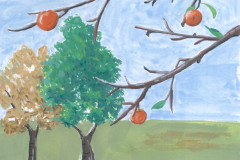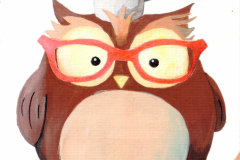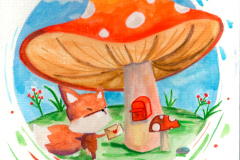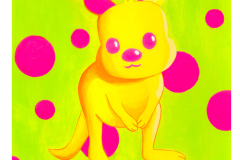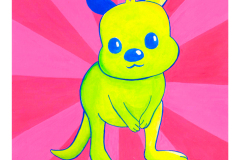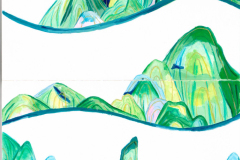Introduction
Natural landscape painting connects you with the environment. Using gouache washes offers a unique way to depict nature’s colors and forms. Gouache paint stands out because of its opaque quality, allowing bold and vibrant paintings. This medium is suitable for artists aiming to represent landscapes realistically or with a creative touch. You can explore different techniques to create textures and depth that reflect the natural world. Learning how to handle gouache helps you express your artistic vision clearly.
The opaque nature of gouache provides practical advantages for landscape painting. Compared to watercolor, gouache hides underlying layers, which helps in making corrections. You don’t need to wait long for paint to dry. These features make gouache ideal for painting outdoors or when you want to work quickly. What kind of landscapes inspire you the most? Understanding how to use gouache washes can transform your painting process and results.
Understanding Gouache as a Painting Medium
Gouache is a water-based paint made from pigment, water, and a binder, usually gum arabic. Unlike watercolor, gouache has a higher pigment concentration, giving it thicker consistency and stronger color. It dries to a matte finish and feels more opaque, allowing you to cover layers easily. This opacity makes gouache ideal for painting natural landscapes where you want vivid color blocking and sharp details.
Compared to acrylic, gouache stays rewettable once dry, so you can easily correct or rework parts of your painting. It does not have the plastic-like finish of acrylic, which can distract from natural scenes. Gouache also dries faster than oils but slower than watercolor, helping you control your wash effects and layering. This balance suits you if you want to capture changing light and texture outdoors.
In landscape painting, these qualities let you work with both broad washes and fine details. They help you create depth and atmosphere that feel close to what you see in nature.
What Makes Gouache Unique
Gouache differs from other paints mainly in its high pigment load and use of a chalk-like opaque filler. This makes the colors appear rich and dense on paper. The binder, often gum arabic, suspends pigments and controls how the paint spreads and sticks.
Your brush strokes with gouache can feel smooth or textured depending on water amount. Since it’s opaque, you can paint light colors over dark ones without blending. This lets you build layers that stand out clearly.
The paint dries quickly but stays workable if you add water back, making it flexible for changes. It also adapts well to different papers, which affects how it absorbs and sets. These qualities make gouache distinct and useful especially for painting detailed landscapes where you need control and a broad range of effects.
Applications of Gouache in Art
Artists use gouache for various styles, but it works especially well in landscape painting. The strong opacity lets you capture sky gradients, distant hills, and foliage with vibrant color blocks. You can easily layer washes to suggest mist or sunlight.
In commercial art, gouache is popular for its flat, matte finish, which reproduces well in prints. It also dries quickly, speeding up the design process. You might find it in posters, children’s books, and fashion sketches.
If you paint natural scenes, gouache gives you the chance to balance bold colors with fine details. Have you noticed how it feels like you can “fix” mistakes more easily here than with acrylic or watercolor? This flexibility can keep you exploring and experimenting until your vision matches what you want to express.
Choosing the Right Materials for Gouache Landscape Painting
Your choice of materials plays a major role in painting landscapes with gouache. This paint works best when paired with the right paper, brushes, and palette. The paper needs to handle both wet washes and thick, opaque layers without buckling or tearing. Good brushes will allow you to create textures, from soft skies to crisp leaves. A suitable palette helps you mix colors efficiently, maintaining the fresh look gouache is known for. Choosing quality paint brands ensures your colors stay vibrant and consistent throughout your work. When selecting materials, think about what kind of landscape details you want to achieve. Do you need sharp lines or smooth blends? Asking yourself questions like these will guide your material choices and improve your painting results.
Selecting Suitable Paper
The paper you select makes a big difference in how gouache paints look and behave. Look for thick watercolor or mixed media papers that can absorb water without warping. Papers with a weight of 300 gsm or more hold up best under multiple gouache layers. Surfaces with a slight texture, called cold-pressed, help create natural effects like rocks or tree bark. Hot-pressed papers, which are smooth, work well when you aim for fine details. Using the wrong paper can cause colors to puddle or lift easily. Try different brands like Arches, Canson, or Fabriano to find which paper suits your style. A good paper will let you layer washes and opaque paint without damaging your work.
Brushes and Tools for Gouache
Your brushes shape the textures and details in your gouache landscapes. Synthetic brushes hold their shape and are easier to clean after gouache, which can dry fast. Round brushes ranging from size 4 to 12 let you paint fine lines and broad strokes. Flat brushes help lay down large washes evenly. Filbert brushes combine flat and round edges, making them useful for shaping leaves or clouds. Small detail brushes allow you to add highlights or textures like tree branches and grass blades. Don’t forget tools like sponge or palette knives for unusual effects. Experiment with different tools to build a toolbox that matches the natural features you’re painting.
Setting Up Your Workspace for Gouache Painting
Organize your painting area around your needs. Choose a flat surface that keeps your paper steady. Make sure you have enough space to spread out your brushes, paints, and water containers. Think about how you will keep your gouache paint tubes or pans easy to reach. Set up a palette near your workspace so you can mix colors without spilling.
Light affects how you see colors. Position your workspace near a window or use bright, natural daylight bulbs. Angle your light to avoid shadows on your paper. A comfortable chair and table at the right height help you paint longer without strain. Keep paper towels or rags nearby to clean brushes quickly and prevent colors from muddying.
When painting with gouache, controlling moisture matters. Prepare a water cup that is large enough but stable to avoid spills. Store your wet palette in a covered container if you take breaks. Think about how to protect your workspace from paint splatters. Does your area invite focus and creativity?
Indoor Workspace Tips
Arrange your gouache materials for easy access. Group brushes by size and type in a cup or tray. Place tubes or pans where you can see the colors easily. Use a palette with wells or mixing areas to keep colors separated. Clear the tabletop of distractions and clutter that slow you down.
Natural light is best for seeing true colors. Work near a window that gets steady daylight. If that’s not possible, use daylight bulbs that mimic sunlight. Position your light source to shine from your non-dominant side, reducing shadows on your paper. Maintain good ventilation to avoid lingering paint odors.
Keep your paper flat by taping it down or using a drawing board. A slight angle can prevent glare but don’t lean the paper so far it distorts your perspective. Have a water container, paper towels, and a palette close by. These small steps create a smooth workflow that helps you focus on painting nature’s details.
Painting Outdoors Effectively
Take only what you need outdoors. Use a lightweight, portable palette that holds your gouache paints securely. Choose a sturdy easel or lap board for stability. Pack brushes, water container, paper towels, and paper or sketchbook in a bag that’s easy to carry.
Select a comfortable spot with good light but avoid direct sun on your paper, which dries paint too fast. Find shade or use a portable umbrella. Consider the wind; clip your paper or pad down to keep it from moving. Have a small towel for wiping hands or spills.
Work quickly to capture the scene before light and weather change. Prepare your color mixes beforehand but stay flexible to adjust for shifting light and shadows. Ask yourself which shapes or colors catch your eye the most. Painting outdoors with gouache means balancing speed with detail in nature’s changing setting.
Basic Techniques with Gouache Washes
Mixing and Applying Washes
Creating smooth washes with gouache starts with mixing paint and water in the right balance. Use a flat brush and begin by adding clean water to your paint on the palette. The more water you add, the more transparent the wash becomes. Test your wash on scrap paper to check if the color appears even and soft. Avoid thick blobs or streaks by applying the wash in long, consistent strokes.
Always keep your brush wet but not overloaded to maintain control. Work quickly before gouache starts drying to blend colors smoothly. Adjust the water ratio as you paint to control how much light passes through your layers. How transparent do you want your colors to be for different parts of the landscape? Remember, thin washes capture sky and water reflections well, while slightly thicker ones add solid shape to trees and rocks.
Layering for Depth and Texture
Layering multiple washes helps build depth in your landscape paintings. After each layer dries completely, apply the next wash with slightly more pigment or less water. This approach enriches colors and allows you to add subtle shadows and highlights.
Use different brush strokes and vary the opacity on each layer to create texture in natural elements like grass or tree bark. Try dry brushing over a near-dry layer to simulate rough surfaces. How can you think about layering like stacking pieces of the scene in front of you? Start with broad, light washes for the background and work toward detailed, darker layers in the foreground. Patience in layering delivers realistic landscapes with a sense of space and texture.
Capturing Natural Light and Colors
Observing natural light closely changes how you paint landscapes with gouache washes. Light shapes the mood and depth of a scene, so watching it carefully helps you see how shadows fall and colors shift throughout the day. Notice how morning light casts cool, soft shadows, while afternoon sun warms the colors and sharpens contrasts. Try sketching at different times to capture these effects in your work.
When you paint, ask yourself how light interacts with objects. Does it bounce between surfaces or filter through leaves? Watching the subtle changes in light makes your gouache washes appear more natural and alive. A simple way to practice is to pick one spot and observe it for 15 minutes, noting how light changes and how it alters color and shadow.
Observing Light in Nature
Spend time outside observing how sunlight affects colors and shadows. Notice areas of direct light that look brighter and warmer. Watch shaded spots that appear cooler or more muted. Shadows are not just gray; they carry subtle hues based on reflected light around them. For example, shadows under trees often have hints of green from leaves reflecting light.
Use your eyes like a camera, focusing on how light defines shapes and textures. You can take quick color notes or swatches to remember what you see. Paying attention to color temperature—warm or cool—helps in selecting precise gouache mixes. Ask yourself: What colors emerge when light changes? How deep or soft are my shadows?
Mixing Colors for Realism
Mix gouache colors slowly to better match what you see in nature. Start with basic colors and add small amounts of complementary shades to adjust brightness and tone. Avoid using pure colors straight from the tube; blends create the natural, subtle variations found in landscapes. For instance, add a touch of blue or green to earth tones to reflect natural shadow colors.
Try creating color swatches that mimic the main tones in your scene before applying washes. Layer your mixes lightly so you can adjust the color intensity as you paint. Mixing a range of light and dark values will help build form and depth. Reflect on the colors around you and experiment until your paint reflects the complexity of natural light in your landscape.
Adding Detail and Texture with Gouache
Using gouache to add fine details and texture can transform your landscape into a vivid scene. Achieving precision requires control and patience. Small brushes help you paint delicate elements like leaves, bark patterns, and blades of grass. Work slowly, building layers of thin paint over dry areas. Each layer adds depth without losing the work underneath.
Experiment with different brush sizes and shapes. A pointed round brush works well for thin lines like twigs or veins on leaves. Flat, small brushes help create straight edges and textured surfaces. You can use opaque gouache for highlights and thin washes for subtle shadows. Think about the shapes you see around you—how do bark textures change on different trees? How do blades of grass overlap and catch light?
Techniques for Fine Details
Focus on layering when adding fine details. Apply multiple thin strokes instead of one thick stroke. This method keeps details clear and crisp. For leaves, start with a flat color, then add veins and edges with darker or lighter tones. Bark benefits from short, irregular strokes to mimic roughness. You can also lift paint gently with a damp brush to create texture or highlights.
Using a small brush, work slowly and observe your subject carefully. Try to capture the unique shapes and lines. Are the leaves jagged or smooth? Does the grass bend with the wind or stand straight? These observations guide your brushwork and make your painting more convincing.
Creating Texture Effects
Dry brushing lets you add rough, grainy textures by using a brush with little paint and dragging it lightly over the surface. This works well to suggest rough bark or rocky ground. You control the texture by adjusting pressure and brush direction. Try it over a dry layer of paint to create subtle contrasts.
Stippling creates texture with small dots of paint. Use the tip of a stiff brush to apply dots in clusters or patterns. Stippling can imitate leaves, gravel, or moss. Play with color changes and dot size for natural effects. Which parts of your landscape would gain depth from tiny dots? How can you vary texture to make the scene more engaging?
Combining Gouache with Other Media
Gouache works well with other art materials, giving your landscape paintings more depth and texture. When you paint broad, opaque layers with gouache, you can add transparent watercolor washes on top or underneath to create interesting color shifts and subtle light effects.
Using watercolor before gouache lets you establish quick backgrounds with gentle gradients. Then, gouache adds solid shapes and details that pop. If you try watercolor after gouache, it might not blend smoothly, so keep watercolors light and limited.
Some artists mix colored pencils with gouache to sharpen edges or show fine details. You can lay down a thick gouache base and then use pencils to draw tree branches or grass blades.
How will combining these materials change how you depict nature’s textures? Experiment with layering and see which mix suits your style best. This blend expands your toolbox without losing gouache’s unique opaqueness.
Mixed Media Approaches
Transparent watercolors highlight gouache’s solid colors by offering soft washes beneath or around opaque shapes. Watercolors dry lighter and allow light to shine through, while gouache blocks light with heavier pigment.
This difference helps when painting skies, water, or distant hills. Use watercolor first for smooth layering and glazing, then apply gouache for closer objects or corrections.
If you paint gouache over heavily pigmented watercolor, the surface may lift or crack. Timing matters—gouache works best on fully dry watercolor layers. You’ll notice your strokes stay crisp with less blending.
When should you pick one over the other? Watercolor suits loose and ethereal effects. Gouache fits bold, graphic shapes or covering mistakes. Think about your scene’s mood and how each paint moves on paper.
Enhancing Details with Pencils
After your gouache layers dry, adding colored pencils or ink can bring sharpness and contrast to your landscapes. Pencils are perfect for thin lines like blades of grass, tree bark texture, or distant fences.
Colored pencils add subtle shading, while ink pens offer strong outlines or fine stippling. Pencil marks glide over gouache easily, but test before applying heavy pressure to avoid scratching the painted surface.
You can build texture by layering pencil strokes on top of gouache’s solid fields. This technique helps you combine bold shapes with delicate details, making your artwork more dynamic.
Try using warm colored pencils on cool gouache areas to create vibrant contrasts. How might this strategy help your landscapes feel more alive? Adding this finishing touch pulls the whole composition together with defined edges and highlights.
Developing Your Style and Practice Routine
Building a Practice Habit
Set a regular time each week for your gouache landscape painting. Consistency helps you improve faster and keeps ideas flowing. Start with small, clear goals, such as completing a quick wash study or focusing on a single natural element like trees or clouds. These smaller steps build confidence and skill over time. Track your progress by saving your paintings and reviewing them weekly. Ask yourself: What did I learn from this session? What would I like to try next? If your schedule is busy, even 20 minutes of focused painting counts. Planning ahead can prevent skipped sessions. Choose a space that invites creativity and gather your favorite brushes and colors. A steady routine will bring improvement and deepen your connection with painting landscapes.
Finding Your Artistic Voice
Try different compositions to see what feels right to you—tight close-ups of leaves or wide open fields. Mix colors beyond conventional greens and blues to reflect how you see nature, not just how it looks. Experiment with brushstrokes: use rough, bold marks for texture or smooth washes for softness. Ask yourself what mood or feeling you want each piece to communicate. Your voice grows by testing new limits and deciding what sticks. Keep notes on what techniques or palettes engage you most. Over time, your style will emerge naturally as you make more deliberate choices. How does your version of nature’s beauty differ from others’? Focus on that, and your landscapes will gain strength and personality.
Conclusions
Gouache painting offers a practical and exciting experience for natural landscape art enthusiasts. Using this medium gives you control over color intensity and paint layering. By experimenting with washes and opaque layers, you can capture the nuances of light, shadow, and texture. Taking your painting outdoors adds authenticity and immediacy to your work. Regular practice with gouache builds your confidence and skill for creating landscapes that resonate with viewers.
Apply the tips and techniques shared to improve your natural landscape paintings. Remember, each painting is an opportunity to observe nature carefully and translate that observation onto paper. The use of gouache enhances this process through its versatility and vibrant finishes. Will you explore new subjects or develop your signature style? Experiment with your art and allow your landscapes to tell their own stories.



















